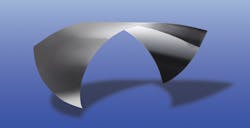New Magnetic Sheets Silence the Noise
Download this article as a .PDF
Today’s products, such as smartphones, have become smaller and thinner while still offering multi-functional performance. One example of multi-functional capability is a product that contains both near-field communications (NFC) and wireless charging technology. Thus, it is even more essential that noise is adequately suppressed in today’s electronic products. One method of suppressing noise is by using magnetic sheets.
TDK Corp. is one company that offers magnetic sheets for noise suppression. The company recently expanded its Flexield series by introducing the new IFM10M noise suppression sheets, which can be used in a number of products (see figure). According to Harvey Espinoza, director of product marketing, communications devices business group at TDK Corporation of America, “The magnetic sheets are used in various types of electronic devices, such as smartphones, tablets, notebooks, stylus pens, point-of-sale (POS) systems, and industrial terminals.”
The IFM10M magnetic sheets feature a laminated design, consisting of a magnetic layer and a copper-plated layer. With a total thickness of 0.04 mm, the new IFM10M sheets are 60% thinner than existing magnetic sheets with a similar magnetic layer thickness, according to the company. Furthermore, the new sheets cover a frequency range of 500 kHz to 10 GHz. The dimensions are 300 × 200 mm. In addition, the IFM10M magnetic sheets operate over a temperature range of -40 to +85°C.
The thin size of the IFM10M noise suppression sheets allows them to be well suited for slim products, such as smartphones, tablets, notebooks, and stylus pens. Essentially, the sheets are well equipped to be installed in dense environments. According to Espinoza, “As electronic devices become more compact, thinner and multi-functional (NFC, wireless charging), electronic components are increasingly being mounted in higher densities. This increased density can lead to noise emissions from the integrated circuits (ICs), components, and cables interfering with other systems within the electronic device.
“In smartphones, the magnetic sheets have been used on power coils, systems-on-a-chip (SoCs), and have been attached at the surface of flexible cables,” Espinoza continues. “They can be used between printed circuit boards (PCBs) to reduce the effect of noise emissions from one PCB to another.”
The new magnetic sheets offer several benefits, says Espinoza, noting that “the noise-absorbing properties of magnetic sheets can reduce the impact of radiated noise when applied to the radiating sources. The sheets can also be applied to components/circuits that are vulnerable to noise emissions to reduce the potential impact.”
In addition, the IFM10M sheets are flexible, meaning they can be cut to the desired size and shape and installed in very small gaps. Lastly, the company asserts that the magnetic sheets improve receiver sensitivity for stylus input devices that utilize inductive coupling and also improve radio-frequency identification (RFID) performance on metal surfaces.

